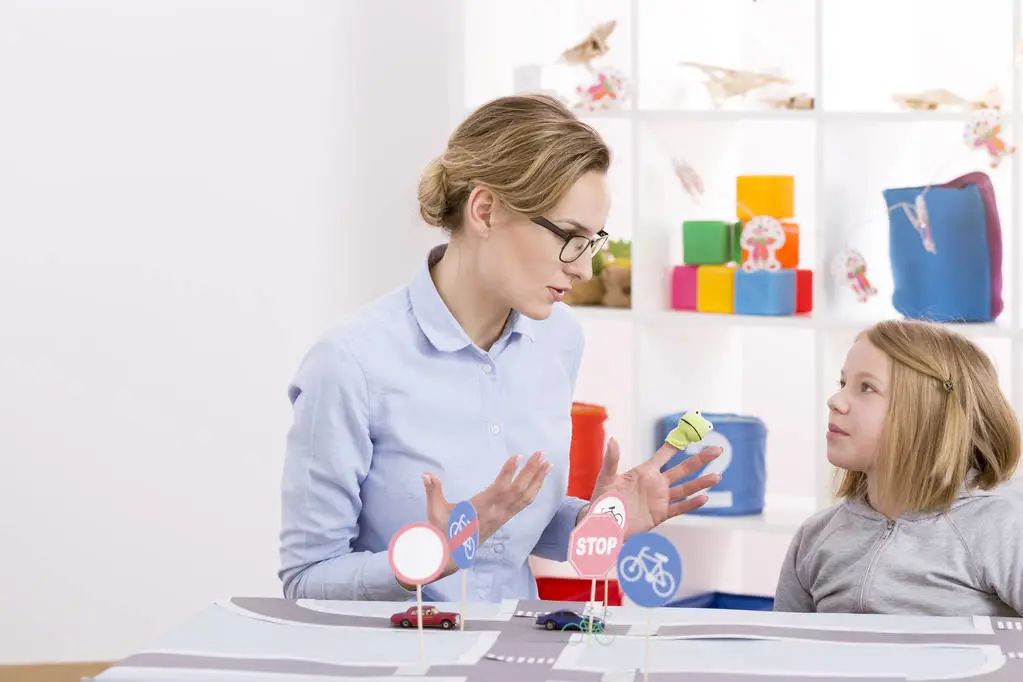
口肌训练到底能帮助孩子开口说话吗?
给家长的关于【非言语口部运动练习】的科普信息
Poster presented at the 2011 ASHA Convention, San Diego, CA
Maggie Watson, Ph.D., CCC‐SLP Gregory L. Lof, Ph.D., CCC‐SLP
University of Wisconsin‐Stevens Point MGH Institute of Health Professions, Boston, MA maggie.watson@uwsp.edu glof@mghihp.edu
安安教育译制
简 介
非语音运动练习 (NSOME) 是指不涉及发出语音,但所谓能够影响说话能力的干预技术。这些通常包括吹泡泡和喇叭,推/摇摆/卷曲舌头,撅嘴/抿嘴等其他嘴部的运动【18】。 虽然许多的言语语言治疗师经常使用,但正规的专业文献驳斥了NSOME作为改善发音,或产生发音的干预方法的正当性【18,24】。
家长可能因为以下几种原因要求使用 NSOME,因为:【15】
孩子以前的治疗师使用 NSOME;
NSOME 的目标可能已经在孩子的 IEP 上;
他们在网上阅读了鼓励 NSOME 的推荐信息;
看到很多可以购买的,在包装有吸引力的 NSOME 产品;
其他专业人士(例如 OT,PT)建议使用;
这些练习只是“治疗”的幌子,其实不过是提供给父母一些可以跟孩子一起玩的事情。
家长的评论 / 问题
回应
问:治疗师在做语言训练之前,让我的孩子练习舌头伸进/伸出,左右来回摇摆。这是个好办法吗?
答:这些非言语的动作练习对发音没有帮助,因为大脑中控制语音运动的部分与控制非语音运动的部分不同。 这是大脑的事情!【3, 6, 10, 25, 27】
问:我的孩子有修复的唇/腭裂。我觉得吹气应该是一个好的方式, 用来帮助他在说话时气息不从他的鼻子跑出来。
答:50多年来,我们已经证实吹气练习不能够阻止(唇腭裂)的孩子说话时气息从鼻子里出来。这种技术仍在使用,实在令人惊讶!【7, 22】
问:我孩子的治疗师说,这是在给我孩子的嘴部“预热”。 这有什么不对的?
答:因为说话仅仅需要非常有限的力量,所以不需要热身。虽然一些简单的口腔运动或许可以让注意力转到嘴部,但这也应该是语言训练很小的一个部分。【5, 24】
问:有人告诉我,许多孩子会被诊断出患有儿童言语失用症。这些练习难道不是帮助他们的言语改善的必要训练吗?
答:患有言语失用症的儿童需要进行专门的言语治疗, 而不是模仿跟发音几乎完全不相关的口部动作 (这是由大脑如何组织信息的方式决定的)。这些孩子患的是“言语”失用症,所以需要训练的是言语, 而不是非言语类的训练。【1, 16】
问:在互联网上,我读到专家提供的信息,他们说这些练习有效,并且是帮助孩子们学会说话所必需的。这些都发布在网络上,所以肯定是对的。
答:在浏览网站上的信息时,你一定要谨慎。研究表明,一种技术是否有效的,并不取决于某个人的意见、推荐或“专家”建议。虽然这些信息可能读起来很吸引人,但它们并不能证明这些练习有效。 如果在这些信息中有鼓励您购买产品的话,就更应该特别小心。【17】
问:我孩子的上一位治疗师说,口部的运动练习将有助于培养必要的言语意识。难道儿童不需要意识到他们的嘴部动作,来提高语言能力吗?
答:研究表明,幼儿对口腔运动根本缺乏认识。儿童需要了解不同的口腔运动如何影响言语,而不是这些跟言语无关的嘴部运动。【14】
问:我的孩子可以快速上下移动他的舌头,那么为什么他不能发出 "舌尖" 的声音,如 "l" 或 "t"?
答:舌头可以做出许多不同的运动;然而,涉及言语的舌头运动,和不涉及言语的舌头运动,分别受控于不同的大脑部位。【2, 3, 26】
问:咀嚼和吞咽不会帮助我的孩子说得更好吗?在我们真正让她说话之前, 她不需要擅长这些非说话动作吗?
答:咀嚼和吞咽与说话无关。虽然舌头、嘴唇等嘴的其他部位都参与言语和非言语运动,但是非言语运动不能影响她的说话方式。【8, 9, 20 ,21】
问:PT和OT经常使用练习来提高运动技能。言语难道不也是运动技能吗?
答:是的,但是言语不仅仅是一种运动技能,因为它还涉及到交流。 语音不同于其他运动任务。言语很特别,因为它涉及语言沟通。 语音相关的运动任务在大脑中是以一种独特的方式组织进行的。【11, 12】
问:有人建议我的孩子接受肌力治疗,因为他"肌张力弱"。所以那一定意味着他的肌肉很弱。
答:肌肉张力和肌肉力量不同。张力是指肌肉在休息时的弹性。 仅仅因为你的孩子的肌肉张力低并不一定意味着她肌肉就弱。加强力量练习不能影响肌张力。【3】
问:我的孩子有所谓的“语音”问题(发音不清楚、音调不恰当等)。 为什么不做口肌练习呢?
答:语音问题是语言方面的问题,这不涉及简单的口部运动。你的孩子需要学习言语/语言的“规则”,这些规则不是通过嘴部运动来学习的。 治疗必须在有意义的沟通环境中进行。【18, 19, 24】
问:我们在家中做这些练习玩得很开心。 做这些有什么不好的呢?
答:虽然这些练习可能不会伤害你的孩子,但专注于语言沟通干预的时间太宝贵了,不能浪费。 在家中的干预应该以练习有价值的,能够提高口语水平的技能为基础。【18, 19, 24】
问:据作业治疗师(OT)说,我孩子之所以有言语问题,是因为她的嘴不够有力量。所以加强嘴部力量不重要吗?
答:产生语音所需的力量很少;需要的是敏捷性和协调性,但力度很少。此外,要准确地测定需要多少强度也异常困难。 因此,任何有关力量弱的说法都是不太可靠的。【4, 23 】
问:我的孩子在治疗中吹喇叭,从一个喇叭一直提升到下一个喇叭。这就是进步,对吧?
答:这是吹喇叭的进步, 但不是语言的进步。吹气和说话完全是两回事,并且互相之间没有任何影响。【25, 26 】
参考资料:
1 ASHA Technical Report on Childhood Apraxia of Speech (2007). http://www.asha.org/docs/html/PS2007‐00277.html
2 Bonilha, L., Moser, D., Rorden, C., Bylis, G., & Fridriksson, J. (2006). Speech apraxia without oral apraxia: Can normal brain function explain the physiopathology? Brain Imaging, 17(10), 1027‐1031.
3 Bunton, K. (2008). Speech versus nonspeech: Different tasks, different neural organization. Seminars in Speech and Language, 29(4), 267‐275.
4 Bunton, K., & Weismer, G. (1994). Evaluation of a reiterant force‐impulse task in the tongue. Journal of Speech and Hearing Research, 37, 1020‐1031.
5 Clark, H. (2003). Neuromuscular treatments for speech and swallowing: A tutorial. American Journal of Speech‐Language Pathology, 12, 400‐415.
6 Forrest, K. (2002). Are oral‐motor exercises useful in the treatment of phonological/articulatory disorders? Seminars in Speech and Language, 23, 1525
7 Golding‐Kushner, K. (2001). Therapy techniques for cleft palate speech and related disorders. Clifton Park, NY: Thompson.
8 Green, J., Moore, C., Higashikawa, M., & Steeve, R. (2000). The physiologic development of speech motor control: Lip and jaw coordination. Journal of Speech, Language, and Hearing Research, 43, 239‐255.
9 Green, J., & Wang, Y. (2003). Tongue‐surface movement patterns in speech and swallowing. The Journal of the Acoustical Society of America, 113, 2820‐2833.
10 Hodge, M., & Wellman, L. (1999). Management of children with dysarthria. In A. Caruso & E. Strand (Eds.), Clinical management of motor speech disorders in children. New York: Thieme.
11 Kent, R. (2000). Research on speech motor control and its disorders: A review and prospective. Journal of Communication Disorders, 33, 391‐428. 12 Kent, R. (2004). The uniqueness of speech among motor systems. Clinical Linguistics & Phonetics, 18, 495‐505.
13 Klein, H., Lederer, S., & Cortese, E. (1991). Children’s knowledge of auditory/articulator correspondences: Phonologic and metaphonologic. Journal of Speech and Hearing Research, 34, 559‐564.
14 Koegel, L., Koegel, R., & Ingham, J. (1986). Programming rapid generalization of correct articulation through self‐monitoring procedures. Journal of Speech and Hearing Disorders, 51, 24‐32.
15 Lof, G.L. (2009). The nonspeech‐oeral motor exercise phenomenon in speech pathology practice. In C. Bower, Children’s speech sound disorders. Oxford: Wiley‐Blackwell, pp. 181‐184.
16 Lof, G.L. (2004). What does the research report about non‐speech oral motor exercises and the treatment of speech sound disorders? http://www.apraxia‐kids.org/site/c.chKMI0PIIsE/b.980831/apps /s/content.asp?ct=464461.
17 Lof, G.L, (2011). Science‐based practice and the speech‐language pathologist. International Journal of Speech‐Language Pathology, 13(3), 189‐196.
18 Lof, G.L., & Watson, M. (2008). A nationwide survey of non‐speech oral motor exercise use: Implications for evidence‐based practice. Language, Speech and Hearing Services in Schools, 39, 392‐407.
19 Lof, G.L., & Watson, M. (2010). Five reasons why nonspeech oral‐motor exercises do not work. Perspectives on School‐Based Issues, 11.109‐117.
20 Moore, C., & Ruark, J. (1996). Does speech emerge from earlier appearing motor behaviors? Journal of Speech and Hearing Research, 39, 1034‐1047.
21 Moore, C., Smith, A., & Ringel, R. (1988). Task‐specific organization of activity in human jaw muscles. Journal of Speech and Hearing Research, 31, 670‐680.
22 Ruscello, D. (2008). An examination of nonspeech oral motor exercise for children with velopharyngeal inadequacy. Seminars in Speech and Language, 29(4), 294‐303.
23 Sudbery, A., Wilson, E, Broaddus, T., & Potter, N. (2006, Nov.). Tongue strength in preschool children: Measures, implications, and revelations. Poster presented at the annual meeting of the American Speech‐Language‐Hearing Association, Miami Beach, FL.
24 Watson, M., & Lof, G.L. (2008). What we know about nonspeech oral motor exercises. Seminars in Speech and Language, 29, 320‐330.
25 Weismer, G. (1996). Assessment of non‐speech gestures in speech‐language pathology: A critical review. Telerounds 35 (videotape). National Center for Neurologic Communication Disorders, University of Arizona.
26 Weismer, G. (2006). Philosophy of research in motor speech disorders. Clinical Linguistics & Phonetics, 20, 315‐349.
27 Wilson, E., Green, J., Yunusova, Y., & Moore, C. (2008). Task specificity in early oral motor development. Seminars in Speech and Language, 29(4), 257‐265.




